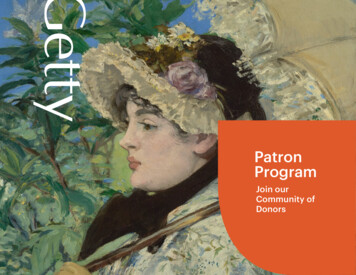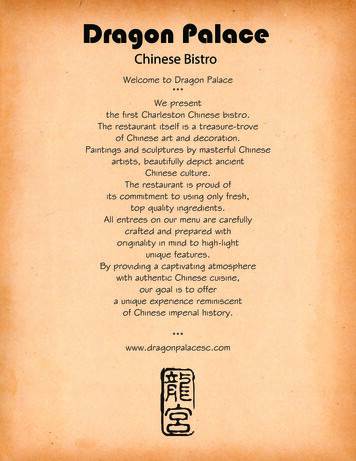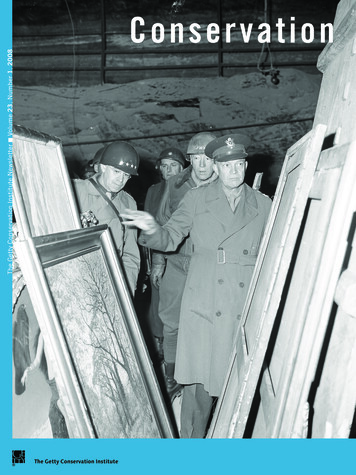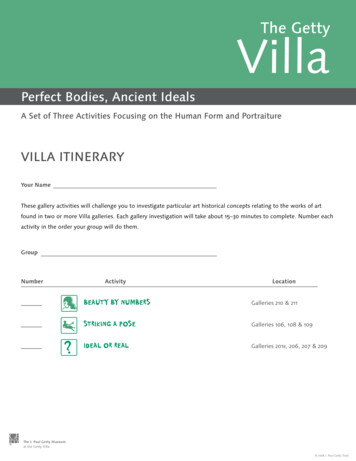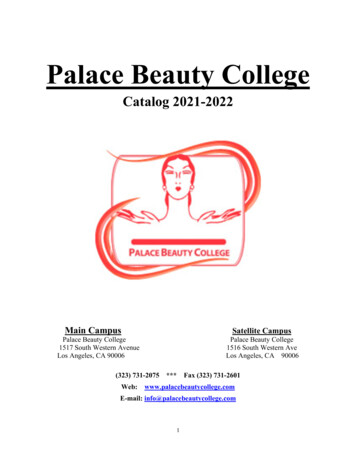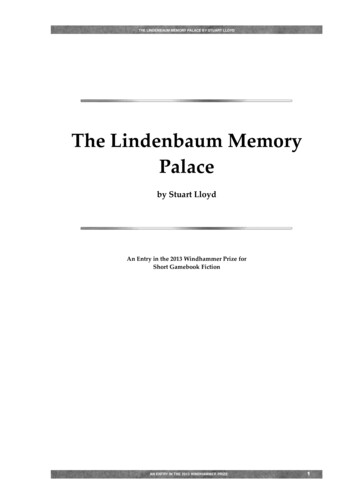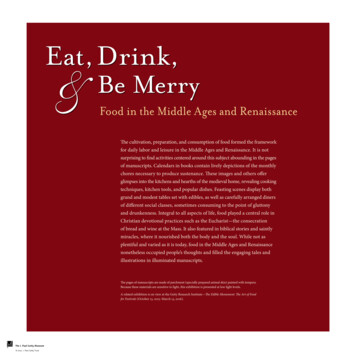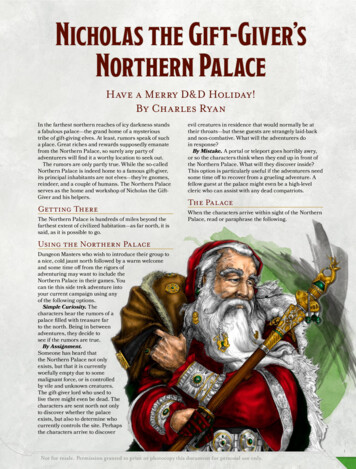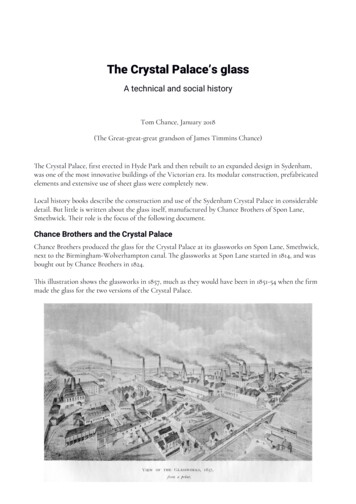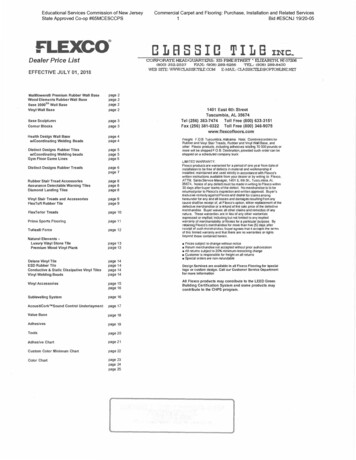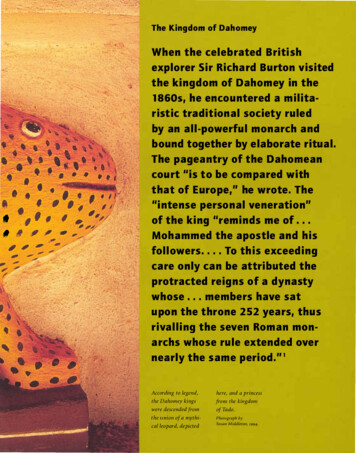
Transcription
The K i n g d o m of D a h omeyW h e n the ce l e b rated B ritishexp l o re r Sir Rich a rd B u rton visitedthe kin g d o m of D a h o m ey in the18605, h e e n co u nte red a milita ristic tra dition a l society ru ledby an a l l-powerfu l m o n a rch a ndbound togethe r by e l a bo rate ritu a l .The p a g ea ntry of the D a h o m e a ncou rt "is t o be com pa red witht h a t of E u ro pe , " he w rote . The"inte nse perso n a l ve n eratio n " of the king "remin d s m e of . . .,Mo h a m m ed the a postle a n d hisfo l l owe rs . . . . To this exceedin gca re o n ly ca n be attributed thep rotra cted reig n s of a dyna styw h ose . . . m e m be rs h ave satu po n the throne 252 yea rs, th u sriva l ling the seven Ro m a n m o n a rchs whose ru l e exten d ed ove rn early the s a m e period . "lAccording to legend,here, and a princessthe Dahomey kingswere descended fromfrom the kingdomof Tado.the IInion of a mythi Photograph bySusan Middleton, 1994.cal leopard, depicted
8T H E K I N G D O M O F D AH O M E YThe histo ry of the DahomeyA royal storyteller;in a society with nowritten language,these heralds passeddown the kingdom'shistory from genera tion to generation.Photograph by T Spiniand G. Antongini, 1972.Time Lineca.1200 Migrations ofkingdom is indeed a long and venerableone. The ancestors of the Fon, a WestAfrican people related to the Yoruba,migrated southward from the Niger Riverin about the thirteenth century, settling inthe southern regions of what are todayBenin and Togo. Bloody quarrels for suc cession divided the royal leaders, and bythe early 1600s, the rival camps had sepa rated into what would become the threewarring kingdoms of Allada, Porto-Novo,and Dahomey.Like many African societies, theFon culture was essentially oral, and thestories that recount the origins of theDahomey kingdom are complex and oftencontradictory. Before the arrival of the firstEuropean visitors to the kingdom in theearly eighteenth century, very little wasactually recorded in written form. For cen turies, chroniclers chosen by the king wereentrusted with perpetuating the culture byreciting stories in public, but their narra tives were largely limited to royal history singing the praises of monarchs past andpresent. Because the heralds could be pun ished by death if they strayed from the offi-14705 First Europeans landFon ancestors. Kingdoms ofin West Africa; slave trade1492 Columbus lands inTado and Allada founded.soon begins.the New World.
9THE KINGDOM OF DAHOMEYcial version, their accounts varied littleover time. Many of these stories are repre sented in the bas-reliefs on the walls ofAbomey's palaces.King Houegbadj a, the third tradi tional Dahomean monarch, is often con sidered the dynasty's true founder. In theseventeenth century, he established thekingdom's capital on the rolling plain ofthe Abomey plateau, where he built thefirst royal palace and developed the admin istrative bureaucracy and the religious andpolitical culture that would come to char acterize the kingdom. Here, too, he initi ated the kingdom's expansionist tradition,conquering the neighboring Gedevi peopleand various other local chiefdoms. He estab lished control over kin groups and burialcustoms, implemented a system of laws to be obeyed under penalty of death - andimposed a head tax, which he used to pur chase firearms, supplementing traditionalweapons such as the spear and the hatchet.During Houegbadja's reign, the Fonpeople first began to call their kingdomDahomey. According to one version of thelegend, Houegbadj a's son Akaba visited thehouse of a Gedevi chief named Dan, whoBas-relief commemo rating the kingdom'sfirst encounter withEuropeans in theearly eighteenthcentury during thereign of King Agaja,who then adopted aEuropean ship asone of his symbols.Photograph byFrancesca Pique, 1994.1685-1708 Akaba rulesDahomey; invents newca.1645-1685 Houegbadjaestablishes seat of Dahomey1600 Gangnihessou and1501 African slaves intro·ca.duced to the Spanish Indies.Dako settle north of Abomey.ca.1620 Dako ascendsthe throne.saber to behead his enemies;promotes such crafts askingdom in Abomey, where hegem-cutting, embroidery,builds the first royal palace.and fabric dying.
11THE KINGDOM OF DAHOMEYopposed Houegbadja's rule. Akabarequested a plot of land on which to builda palace, a request that Dan would havebeen obliged to grant. After Dan reluc tantly complied, Akaba asked for more,soliciting new and larger lots, until at lastDan angrily cried out, "Soon you will bebuilding on my belly!" The next night,Akaba used this breach in etiquette as areason to attack and kill Dan. Upon suc ceeding to the throne, he built his palaceon Dan's grave. In Fon, home means"belly." Thus, the name of the kingdom Dan home-literally means "on the bellyof Dan."It was also Houegbadja who intro duced the Annual Customs ceremonies,which would soon become the kingdom'smost important ritual observance. Devel oped and elaborated by following monarchs,the Customs were a period of festivitiesinvolving the entire population (as wellas any visiting dignitaries) , which bothexpressed and reinforced the ruler's rela tionship with his people. The palace court yards and the town's public squares wereornamented with colorful banners, flags,and pavilions. Voudou ceremonies wereperformed, military parades displayed theking's might, and ritual dances glorified themonarch as the supreme ruler on earth.Voudou initiate in thecostume of Zangbeto,guardian of the night.A somewhat fancifuldepiction of theannual Customsfestivities being wit History of Dahomy:nessed by EuropeanAn Inland Kingdomvisitors. This drawingoriginally appearedof Africa.in one of the firstpublished descriptionsDuring the annualCustoms ceremonies,priests and divinerswere consulted to helpdecide policy for thecoming year.Photograph bySusan Middleton. '997.of the kingdom,Archibald Dalzel's1793 book, TheSecond edition, 1967, pub lished by Frank Cass &Company, Essex, England. Frank Cass & Co. Ltd.Reprinted by permission.1732-1774 Tegbessou rules1708-1732 Agaja rulesDahomey; Ouidah becomes aflourishing port and the king Dahomey during the greatest1724-1727 Dahomey con period of expansion in thequers neighboring states ofkingdom's history. He is theAllada and Ouidah and begins1738 Oyo empire invadesfirst king to have contactto dominate region's slaveDahomey, establishes a trib with Europeans.trade.ute system.dom's second-largest city.
1l\IAccording to traditional Fon belief,the visible world was but part of a vasterreality that included the unseen world ofthe spirits and ancestors. During theCustoms ceremonies, criminals and prison ers of war were sacrificed as "messengers"bearing questions to the "deadland" ofroyal ancestors. Answers from the ancestorswere received through divination, includ ing the spirit possession of voudou priests,thereby consecrating the current regime byreinvoking its ties to the past. The practicetroubled the European visitors who wit nessed it. "The celebration of the Customsusually continues about a month, duringA romanticized late eighteenth-centurydepiction of theDahomey armyheading into battle,reflecting the growingfame in Europe ofthe kingdom's femalewarriors.From Dalzel, History ofDahomy, 1793; second edi tion, 1967, published byFrank Cass & Company,Essex, England. FrankCass & Co. Ltd. Reprintedby permission.1818-1858 Guezo rulesDahomey, liberates kingdom1774-1789 Kpengla rules1789-1797 Agonglo rulesDahomey, strengthens army,Dahomey, opens the kingdom1797-1818 Adandozanmotes palm-oil processing asand conquers coastal cities into Christian and Muslimrules Dahomey; he is over an economic alternative to theca.modern-day Nigeria and Togo.missionaries.thrown in a palace coup.slave trade.countries outlaw the slave trade.from Oyo domination, pro·1830 Several European
13T H E K I N G D O M O F DA H O M E Ywhich there is some exhibition every fourth,or market, day," noted the English adven turer Archibald Dalzel in 1793. "The wholewould afford a very amusing spectacle, ifit were not for the human sacrifices whichare annually made for the purpose of water ing, according to the country expression,the graves of the deceased royal family.'"From legendary origins, then, grewa highly organized and fiercely expansion ist kingdom in which each ruler wagedwar to honor a traditional obligation tomake Dahomey ever greater. In the 1720S,aided by a corps of fierce female warriors,Akaba's brother, King Agaja, overcamelarger armies to subjugate several neigh boring rival kingdoms - including thestrategically critical port town of Ouidah,which by then served as a major center ofthe West African slave trade. The Dahomeywomen warriors were called Amazons bythe Europeans, after the legendary femalewarriors of Greek mythology; they wouldbecome a dynastic tradition.Dahomey's conquests permitted directcommerce with the traders, especially thePortuguese and French, who were export ing an estimated six thousand slaves a yearfrom West Africa to plantations in theNew World. During the second half of theeighteenth century, Dahomey's prowess asa warrior nation allowed it to monopolizethe Ouidah slave trade. Armed withweapons obtained in exchange for slaves,the Fon were able to defend themselvesagainst ongoing threats from the largerOyo empire, a powerful Yoruba kingdomto the east, in what is today Nigeria.Nonetheless, the Oyo succeeded inexacting annual tribute payments fromgenerations of Dahomey's kings. It was notuntil 1818, at the beginning of the reignof Guezo, one of Dahomey's most famousmonarchs, that the Fon were finally able toliberate themselves from their Oyo over lords. In the decades that followed, Guezocontinued to strengthen and expand thekingdom, allying himself with a Portugueseadventurer who had helped him come topower and who, in return, was granted avirtual monopoly over the Ouidah armsand slave trade.' Throughout much of thenineteenth century, Dahomey was one ofthe richest and most powerful kingdoms inAfrica. Its army at this time was estimatedto number some twelve thousand soldiersand four thousand Amazons. The Amazonsconstituted one of the army's elite corps,serving as the king's palace guards andforming a special phalanx that accompa nied the monarch into battle.The Dahomean monarchy, however,would prove no match for the upheavalsthat were to come. The development of theslave trade had attracted Europeans intent
Dahomean womenwarriors, or Amazons.The horns, probablymade of tin, were aninsignia of rank: theseare officers. Hornswere also icons ofpower, associated withsuch animals as theantelope and buffalo;"furious antelope"and "wild buffalo"cadres were amongthe fiercest Amazonbattalions.on exploiting West Africa's economic poten tial. In the 1800s, as international aboli tionist voices called for a worldwide endto slavery, slave traders searched for alter native sources of income. Throughout theregion, European interest shifted to palmoil, which was extracted from the nutsof the area's abundant palm trees and washighly prized for lubricating machineryand as a key ingredient in margarine,candles, and soap. King Guezo establisheda palm-oil industry and attempted toPhotograph by a Frenchm ilitary doctor whoaccompanied the colonialarmy, ca. 1 894- CourtesyGetty Research institute,Research Library, 94.R.56.1858-1889 Glele rulesDahomey, rebuffs Europeanintervention in Dahomey's[affairs.1889-1894 Behanzinrules Dahomey.1851 Dahomean troops1864 Seeking revenge for1892-1894 Frenchunder Guezo attack the Egbahis father's defeat, Gleleinvade and conquer1839 British seizecapital of Abeokuta but areattacks Abeokuta; anotherDahomey; Behanzin ordersPortuguese slave ships;soundly defeated; Amazondefeat leaves Dahomeanhis troops to burn the royalthe slave trade curtailed.cadres incur heavy losses.army severely weakened.palaces at Abomey.
15T H E K I N G D O M O F DAHO M EYincrease Dahomey's agricultural output,though he continued to deal in slaves aswell. Ironically, antislavery efforts drove upthe price of the human "merchandise,"making slave trading even more profitablethan before.Like his father, Guezo, Dahomey'snext king, Gl l , resisted European pres sure to eliminate b oth the slave trade andthe practice of ritual human sacrifice.Sir Richard Burton's visit in the 1860s wasa mission from the British government tonegotiate such matters with the Dahomeanruler. While impressed by the king's regaldemeanor, Burton was disappointed to findthat the monarch would not readily accedeto British demands. "The personal courte sies of the king," he wrote, "compared badlywith his stubborn resolve to ignore, evenin the smallest matters, the wishes of HerMajesty's Government." ( Glele's assessmentof Burton, according to Burton himself,was that the Englishman "was a good man,but too angry." )4Burton conceded that "to abolishhuman sacrifice here is to abolish Dahome.The practice originates from filial piety,it is sanctioned by long use and custom,and it is strenuously upheld by a powerfuland interested priesthood . . . . Gelele, I ampersuaded, could not abolish human sac rifice if he would; and he would not if hecould.'" Regarding the slave trade, Glel responded to Burton that it was a practiceestablished by the Europeans themselves,and he would continue to sell what theEuropeans wanted.tI.1 f"'11'",,-r!" '",1/' 1 "'- '"CARTE Dt.T DArIO :tv.IEY. ,. . 'hll' ''''' ",,-,.r". U ,.,. 'f1. /".,,.1 ,' ./,,,.,. ,,.1,./",,,. " k r,."\.,'. ·,. J ,., "",. III ItIt' ,"', /.1 "'rU'· ''''',.,. . Id Ir'" /.·.\ I ""r r,.,',. ,,,/lU'", ./,. I I",'I.' I :k ,I "'III'", simply "Germancolony" and "Englishcolony"-suggestingLe Petit Journal,lines trace the routesof European explorersa French illustratedand shipping lines;magazine, inSeptember 1892, onthe small tricolor flagsshow the positionthe strategic impor-the eve of the Frenchof French troops.conquest. The legendnotes that the redto the French colonial empire.ritories are labeledMap published inThe neighboring ter-tance of Dahomey1914 World War I begins;1894 Behanzin surrenders;Africans from several FrenchDahomey becomes a Frenchcolonies serve with distinctionprotectorate; Agoli-Agbo Iin the French army.installed on the throne by the1914-1916 Resistance1918 World War I ends;1900 Deposition and exile of1911 The French colonialroyal palaces at Abomeyofficial E. G. Waterlot createsmovements against theGermany loses its Africanbegins.Agoli-Agbo I.casts of palace bas-reliefs.French colonizers organized.colonies.French; first restoration of
16THE KINGDOM OF DAHOMEYLe Petit JournalTOUS I.ES VE DIU:DlSLe Supplemeut illustr;5 C DtimuTroisiemc AnneoSUPPLEMENT ILLUSTREHul tpages :CINQS.A.:M:EDI 20centl'JT es.A.OU"TTOUS !.I:S JornsLe Petit Journal6 CenllmcsNum6ro 91:1. B92Cover ofLe PetitJournal,August 20,1892.In the late nine teenth century, illus trated magazineswere very popularin France. Le PetitJournal, a conserva tive daily that oftensought to glorify theFrench colonial effort,reported regularly onthe Dahomey cam paign. The magazine'scaption claims thatthe "attack of theDahomeans" is being"repulsed by a Frenchgunboat"; in reality,the French retreated,alarming many colo nial officials, whowere astonished thattheir army had lost askirmish to an Africanforce composed largelyof women.ATTAQUE DE I DA:a:OlV:Irepoussee par una canonnierafran9aioeE'ENS
17T H E K I N G D O M O F DA H O M EYIn Dahomean society,battles were commem orated by bas- reliefs.In this one from Gtele'sajalala, a Dahomeanwarrior is shooting aYoruba enemy.Photograph bySuzanne Preston Blier. 1986.By the late nineteenth century, thecolonial powers- primarily Britain, France,Belgium, and Germany-were vying forsuperiority in Africa, which in many respectshad become an arena for the dispute ofEuropean imperial rivalries. The powerfulDahomean army, meanwhile, had beenweakened by several defeats in battles withthe neighboring Egba kingdom. Largely forstrategic purposes, the French sided withanother of Dahomey's longtime enemies,the kingdom of Porto-Novo. Glele's succes sor, Behanzin, also clashed with Franceover such issues as slavery and the right towage war against Dahomey's traditionalenemies. The French found a pretext forconquest in a disagreement over the terms1960 The Republic ofDahomey wins independence.1960-1972 Independencefollowed by period of politicalca.instability; numerous coups1930 Original thatchand attempted coups.roofs of palace buildingsreplaced with corrugated1945 Historic Museum of1972 Regime of revolutionary·metal.Abomey opens to the public.military government begins.
T H E K I N G D O M O F DAH O M E Y\Entree duAhomeyA glorified depictionof French troops car rying the flag intoAbomey. Behanzinhad set fire to theroyal palaces shortlybefore their arrival.Le Petit Journal,ca. December 1892.of the French occupation of the port townof Cotonou. In 1890, Behanzin launcheda preemptive assault on the French atCotonou, but he took heavy losses andretreated toward Abomey. A brief truceensued. Hunkered down in his royal com pound, the last independent monarch torule Dahomey continued to resist Frenchchallenges to the kingdom's independence.Then, in August 1892, a French colo nial army gathered in Porto-Novo marchedon Abomey. A series of fierce battles fol lowed, with Dahomean forces retreatingtoward their capital. In November, KingBehanzin tried one last time to rally hissoldiers, but to no avail. The Frenchdemanded that he lay down his arms; herefused. Finally, heavily outgunned, theking attempted to destroy what he couldnot save. Behanzin ordered his troops toretreat; then, rather than see the belovedpalaces and their sacred tombs fall intoFrench hands, he had the torch put to thehomes of his ancestors. Behanzin and hisarmy disappeared into the bush, wherethey continued to fight a guerrilla war foranother year. The king eventually surren dered to the French on January 25 , 1894.Before departing into French-imposedexile, Behanzin presented a farewell addressto his soldiers. With his palaces destroyed,his court and storytellers dispersed, hisarmy defeated, and his people facing theuncertainties of a colonized future, themonarch wondered whether the powerfulDahomey kingdom might not fade fromthe world's memory. "When my warriorsrose by the thousand to defend Dahomey1975 Name of Dahomey1982 Abomey's palaces are1985 Abomey's palaces areis changed to the People'sdesignated a World Heritageplaced on the list of endan·Republic of Benin.cultural site by Unesco.gered sites by Unesco.
19THE KINGDOM OF DAHOMEYBas-relieffromGuezo's ajalalashowing a warriorplanting a flag onconquered territory.Photograph bySusan Middleton, '994.and its King, I proudly recognized thesame valor shown by the warriors of Agaja,Tegbessou, Guezo, and Glele," he said."Despite our bravery and the justice ofour cause, our troops were decimated . . . .Already my weeping voice awakens no echo.Where are the ardent Amazons? Where,their indomitable chiefs? . . . Where, mycomrades in arms? . . . Who will sing oftheir great sacrifice? . . . Departed companions . . . here is the offering of memorya little oil, a little flour, and blood of thebull. . . . Here the pact is renewed before thegreat departure. Farewell, soldiers, farewell."6Behanzin would die in exile some twelveyears later.Dahomey was proclaimed a Frenchprotectorate, and by the end of 1897, theFrench controlled the entire territory ofthe present-day Republic of Benin, whichthey called the colony of Dahomey. Theyinstalled Behanzin's half-brother, Agoli Agbo I, on the throne, only to depose andexile him and appoint a powerful Frenchgovernor. In 1904 the colony of Dahomeywas integrated into the federation ofFrench West Africa.The French instituted an "indigentsystem," based on the concept that Africanswere not mature enough to take care oftheir own affairs. Africans were consideredsubjects rather than citizens; they had to pay
20THE K I N G D O M O F DAHO M E Y4II.llmlS, lous ami! !Behanzin eX-T'oi du Dahomeysa famille et sa suiteAlgerie. -»"Once he had descended [from the Abomey plateau] to the surround ing plain, [8ehanzin] stopped to look behind him. The entire plateauwas in flames and the sky above like a calabash of blood. AfterAbove: French post card, ca. 1905, show the high priests went into prayer, and the bokono made divinationsing Behanzin in exilewith his family andservan ts, shortly beforehis death. Opposite:having watched his palace go up in flames, [8ehanzin] remainedmotionless with his head between his hands. Respecting his grief,to know what the future now held in store for them. Finally he gotAgoli-Agbo I, ca. 1894,up. Then with his faithful followers of Amazons, bokono, warriors,soon after the Frenchhigh priests, women, and children he set off for the forest. There ininstalled him on theits womb he lived for almost two years, unbeknownst to the Frenchwho hounded him like a beast, protected by his gris-gris and thethrone. An Amazonbodyguard, wearingmagic of his bokono."horns, can be seenMaryse Conde, 1997 by theThe Last of the African Kings.University of Nebraska Press. 1992Editions Mercure de France.Translated by Richard Philcox. Reprinted by permission.behind one of theking's wives.Courtesy Getty ResearchInstitute, Research Library,ZPC 2 (above), 94. R.56(opposite).
22T H E K I N G D O M O F DAHO M E YDifferent gradesofpalm oil atAbomey market.Photograph byLeslie Rainer, '994.Modern bas-relief byCyprien Tokoudagbaand family depict ing the symbol ofAgoli-Agbo fa foot about to tripover a rock. Theaccompanying motto,"J stumbled butJ did not fall," aptlyexpresses the Fanpeople's endurance.Photograph bySusan Middleton, '997.taxes while undergoing severe restrictionson personal and political freedom. AlthoughDahomey had historically derived itsstrength from its fierce warrior kings, mostof its people were farmers who tended fruittrees, raised livestock, and planted nativecrops like yams, millet, and cotton, as wellas the maize, tobacco, and coffee importedfrom the New World by European traders.French governance, which aimed to enrichthe French economy at the expense of thecolony, overexploited the land's resources.Behanzin's concerns regarding thefate of Fon culture proved well founded.The French instituted a system of socialservices, establishing health centers in theprincipal towns and implementing aneducational system developed largely byCatholic missionaries, who had first estab lished schools there in the 1860s. The colo nial schools systematically tried to obscureDahomey's traditional culture. The Frenchconsidered African culture generally tobe uncivilized; they attempted to forceindigenous Africans to abandon their ownroots, embrace the civilization of ChristianEurope, and adopt the French language.Despite such pressures, however, theFon people managed to hold fast to theirown cultural beliefs, partly by drawing ontheir long-standing, deeply ingrained oraltraditions. At the same time, Dahomeybecame the "Latin Quarter of West Africa,"known for its writers, professionals, andartists. And, ironically, leaders of an orga nized anticolonial protest movementemerged from the ranks of intellectualstrained in the French-instituted schools.Immediately following World War II,Dahomey's educated elite began carryingout protests against the colonial govern ment. In 1958, the French finally granted apopular vote to decide statehood, and thefollowing year, the Republic of Dahomeybecame an independent member of theFrench Community of states. Dahomey,however, continued to press for completeautonomy, and on August 1, 1960, aftersixty-six years of French government, theindependent Republic of Dahomey installedHubert Maga as its first president.The new state survived a period ofturbulent political activity from 1960 to1972, followed by a revolutionary militaryregime under General Mathieu KeH'koufrom 1972 to 1990. Although the new govern ment was initially embraced by the popula tion, discontent soon became widespread,and in 1990 the single-party government wasdismantled. A period of democratic renewalfollowed; in the new Republic of Benin'sfirst presidential election, Nicephore Soglowas voted into office in 1991, and in 1996,Kerekou- by then an advocate of democra tic rule - was elected president.'
Throughout the tumultuous twen tieth century, the Fon - Iargely throughart and ritual- have preserved a con nection to their cultural identity. Today'sking, a descendent of Agoli-Agbo J, isan elected representative of the royal fami lies of Abomey who fulfills an essentialceremonial function. The Fon continueto revere their traditional leaders and torespect many age-old customs. The royalcompound at Abomey serves as the heartof those observances and houses themuseum where the Dahomey kingdom'streasures are displayed. A century afterBehanzin's surrender to the French, theplea implicit in his farewell address-thatthe Dahomean dynasty not be forgotten has found its echo.Campaign rally forNOTES1. Richard Burton, A Mission to Ge/ele, King ofDahome (1864; reprint, with an introduction andnotes by C.W. Newbury, London: Routledge andKegan Paul, 1966), p. 149·2.Archibald Dalzel, The History of Dahomy: AnInland Kingdom of Africa (1793; reprint, London:Frank Cass and Co., 1967), pp xxi-xxii3. This story is vividly-if sorrowfully-recountedin fictional form in Bruce Chatwin's short histori cal novel The Viceroy of Ouidah (New York:Penguin Books, 1980), which was made into thefilm Cobra Verde by the German director WernerHerzog.4. Burton, A Mission to Gele/e, pp.347, 348-5. Ibid., pp. 235-36.6 Jean Pliya, Dahomey (Issy-Ies-Moulineaux:Classiques Africains, 1975), pp. 127-28.7. The Republic of Benin should not be confusedNicephore Soglo, thefirst elected presidentof the Republic ofBenin, in the squarein front of themuseum. The parasolshading the currentceremonial king,Agoli-Agbo Ill, bearsthe emblems of theDahomean monarchswho preceded him.Photograph byFraneesea Pique, 1996.with the modern Nigerian city of Benin, orwith the historical kingdom of Benin, situated inpresent-day Nigeria and also renowned for itsart-particularly its bronzes.1988 Fifty-six bas-reiiefsdetached from one of Gillie'spalace buildings (ajalala) and1988-1997 Gillie's1989-1990 Benin becomeslaborative project of the Gettyajalala, structurally dam a democracy; name changedConservation Institute and the1997 "Past, Present, and Future of the Royal Palaces and Sitesof Abomey," a conference sponsored by the Getty ConservationInstitute, the International Center for the Study of thePreservation and Restoration of Cultural Property (ICCROM). andaged, is rebuilt.to Republic of Benin.Republic of Benin.the Republic of Benin, is held in Abomey.1993-1997 Conservationplaced in storage.of bas-reliefs at Abomey in a col
26WA R R I O R K I N G S Wa rnoKiru s Li ke the p h a ra o h s of Egypt o r the g reat k i n g s of Persia.the monarchs of Dahomey formed the epicenter of all spheresof the kingdom's l ife - pol itical. soci a l. rel i g i o u s. and m i l i ta ry. A D a homea n ki n g w a s ve nerated a s the dokunnon(master a n d possessor of a l l riches). the simido (m a sterof the worl d). a n d the ainon (em i nent m a ster of the ea rth).Upon a s s u m i n g the t h ro n e. each m o n a rch too k on theo b l i g ation to leave beh i n d more te rrito ry t h a n he i n he rited .The D a homea n m o n a rchy. therefore. waged a n o n g o i n gseries o f wars o f con q uest that. by t h e early n i neteenth cen tury. had made Da homey one of the most powerfu l kingdomsin Africa .To h e l p e n s u re the m o n a rchy's l o ng -term sta b i l ity.the tra nsition between one king a n d the next was a ided bya u n i q u e system of rules govern i n g succession. Under thisprinciple. known a s vldaxo. the aging m o n a rch selectedfro m a mong h i s sons the one best su ited to rule. s u bj ectto a p prova l by roya l m i n i sters a nd d ivi ners. W h e n a pri ncewas enth roned. he wou l d sel ect a " n a m e motto"- a slog a nt h a t expressed s u c h attri butes a s strength. wisd om. a n dcu n n i n g - a s wel l a s a roya l n a m e. or " stro ng n a me." H ewou l d a l so adopt a n u m ber of em b l e m s or sym bols. whichserved to promote h i s stro ng name a n d motto. wa rn hisenem ies a n d riva l s. co m memorate h i s con q uests. a nd. InPrevious page: Textileapplique with symbolsof the twelve kingstraditionally acknowl g e n era l. p u b l icize an a u ra of c h a r i s m atic roya l power.These sym b o l s were depicted o n b a s-rel iefs a nd o nedged to have ruledco lorfu l b a n ners a nd a pp l i q u6s. w h i ch. d u r i n g t h e g reatDahomey.a n n u a l festivities know n a s the "Cu stom s." decoratedPhotograph bySusan Middleton. 1997.the p a l ace cou rtya rd s.
27WA R R I O R K I N G S--- (j'/ 1 I D Gangnihessou (reigned ca. 1600). .II Houegbadja (reigned ca. 1645-85;son of Gangnihessou, nephew of Dako)SYMBOLSA male gangnihessou bird; a drum; a throw ing or hunting stickSYMBOLSMOTTOMOTTO"J am"The fish who has escaped the net won'tgo back in it."the biggest bird and the loudest drum.You can't keep the bird from singing, youcan't keep the drum from beating."Gangnihessou's motto notwithstanding, hisyounger brother Dako usurped the throne.-" . . . . . . . - " " .A fish; a fish trap; a war club hoeHouegbadja's accession to the thronewas seen as a rehabilitation of his father.Houegbadja is considered the founder ofthe Dahomey dynasty; he established thecapital in Abomey, where he built a newpalace, initiated a system of laws, estab lished a bureaucracy, presided over reli gious ceremonies, and created a powerfulpolitical culture. His motto expresses theking's wisdom in refusing to be caught intraps laid by his enemies.EJ Dako (reigned ca. 1620; youngerbrother of Gangnihessou)SYMBOLSAn indigo jar; a tinderbox; a war clubMOTTO"Dako kills Konou as easil
a warrior nation allowed it to monopolize the Ouidah slave trade. Armed with weapons obtained in exchange for slaves, the Fon were able to defend themselves against ongoing threats from the larger Oyo empire, a powerful Yoruba kingdom to the east, in what is today Nigeria. Nonetheless, the Oyo succeeded in exacting annual tribute payments from

